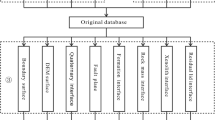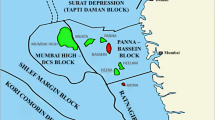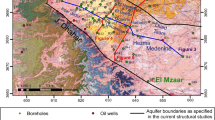Abstract
The construction of fine-scale three-dimensional models of deep structures at a regional scale remains challenging. These models can be significantly benefitted by focusing on the binary lithological architecture (i.e. different lithologies in the hanging wall and the footwall), which exists in several types of structures, such as detachment faults, domes and intrusion contact zones. Along these lines, in this work, a novel approach to the three-dimensional modelling of deep structures was proposed by using the level set method and transforming the geometric construction of deep structures into the lithological distribution interpreted from the gravity data. With this method, first, an initial model was constructed that provides a general model frame. Subsequently, the initial model was optimized to generate a refined model that represents fine-scale features of deep structures. The initial model was established based on the high-density geological data and extrapolation of trends. The refined model was reconstructed from the stepwise addition of the geological–geophysical data to the initial model, including gravity data, seismic profiles and geological knowledge. This was achieved through the parametrization of the initial model as the level set function to convert the data to a series of weighted misfit functions, which were solved by the gradient descent algorithm. In addition, the proposed approach was applied to the modelling of the Zhaoping detachment fault in the Jiaodong Peninsula, Eastern China. Interestingly, the lithologies of the hanging wall and the footwall are Precambrian metamorphic rocks and Mesozoic granite, indicating a binary feature. An initial model and two stepwise refined models were also constructed. From the extracted modelling results, it was demonstrated that the errors of location and morphology of the refined model were 1% and 30%, which were lower than those of the initial model (8% and 100%), demonstrating the effectiveness of the developed refined modelling approach. This work provides a new and powerful three-dimensional modelling approach for geological structures by effectively integrating both geological–geophysical data and knowledge. Owing to the unique flexibility of manipulating surfaces and incorporating data, the proposed modelling approach has the potential to be easily extended to the modelling of other types of deep structures, as well as application to other geophysical data.





















Similar content being viewed by others
References
Asaue H, Kubo T, Yoshinaga T, Koike K (2012) Application of magnetotelluric (MT) resistivity to imaging of regional three-dimensional geologic structures and groundwater systems. Nat Resour Res 21(3):383–393. https://doi.org/10.1007/s11053-012-9184-2
Austin J, Blenkinsop T (2009) Local to regional scale structural controls on mineralisation and the importance of a major lineament in the eastern Mount Isa Inlier, Australia: Review and analysis with autocorrelation and weights of evidence. Ore Geol Rev 35(3–4):298–316. https://doi.org/10.1016/j.oregeorev.2009.03.004
Bierlein FP, Murphy FC, Weinberg RF, Lees T (2006) Distribution of orogenic gold deposits in relation to fault zones and gravity gradients: targeting tools applied to the Eastern Goldfields, Yilgarn Craton, Western Australia. Miner Deposita 41(2):107–126. https://doi.org/10.1007/s00126-005-0044-4
Bigi S, Conti A, Casero P, Ruggiero L, Recanati R, Lipparini L (2013) Geological model of the central Periadriatic basin (Apennines, Italy). Mar Pet Geol 42:107–121. https://doi.org/10.1016/j.marpetgeo.2012.07.005
Boszczuk P, Cheng LZ, Hammouchie H, Roy P, Lacroix S, Cheilletz A (2011) A 3D gravity data interpr-etation of the Matagami mining camp, Abitibi Subprovince, Superior Province, Québec, Canada: application to VMS deposit exploration. J Appl Geophys 75(1):77–86. https://doi.org/10.1016/j.jappgeo.2011.06.031
Cecil T, Qian JL, Osher S (2004) Numerical methods for high dimensional Hamilton–Jacobi equations using radial basis functions. J Comput Phys 196(1):327–347. https://doi.org/10.1016/j.jcp.2003.11.010
Chang KW, Yoon H (2018) 3-D modeling of induced seismicity along multiple faults: magnitude, rate, and location in a poroelasticity system. J Geophys Res Solid Earth 123:9866–9883. https://doi.org/10.1029/2018JB016446
Cloetingh S, Podlachikov Y (2000) Perspectives on tectonic modeling. Tectonophysics 320(3–4):169–173. https://doi.org/10.1016/S0040-1951(00)00154-2
Deng J, Yang LQ, Li RH, Groves DI, Santosh M, Wang ZL, Sai SX, Wang SR (2019) Regional structural control on the distribution of world-class gold deposits: an overview from the Giant Jiaodong Gold Province, China. Geol J 54(1):378–391. https://doi.org/10.1002/gj.3186
Deng J, Yang LQ, Groves DI, Zhang L, Qiu KF, Wang QF (2020) An integrated mineral system model for the gold deposits of the giant Jiaodong province, eastern China. Earth Sci Rev 208:103274. https://doi.org/10.1016/j.earscirev.2020.103274
Deng H, Zheng Y, Chen J, Yu SY, Xiao KY, Mao XC (2022) Learning 3D mineral prospectivity from 3D geological models using convolutional neural networks: application to a structure-controlled hydrothermal gold deposit. Comput Geosci 161:105074. https://doi.org/10.1016/j.cageo.2022.105074
Dorn O, Lesselier D (2006) Level set methods for inverse scattering. Inverse Prob 22(4):R67–R131. https://doi.org/10.1088/0266-5611/22/4/R01
du Bray EA, John DA, Cousens BL (2014) Petrologic, tectonic, and metallogenic evolution of the southern segment of the ancestral Cascades magmatic arc, California and Nevada. Geosphere 10(1):1–39. https://doi.org/10.1130/GES00944.1
Fallara F, Legualt M, Rabeau O (2006) 3-D integrated geological modeling in the Abitibi subprovince (Québec Canada): techniques and applications. Explor Min Geolo 15(1–2):27–41. https://doi.org/10.2113/gsemg.15.1-2.27
Farguharson CG, Mosher CRW (2009) Three-dimensional modelling of gravity data using finite differences. J Appl Geophys 68(3):417–422. https://doi.org/10.1016/j.jappgeo.2009.03.007
Fat’yanov II, Khomich VG, Boriskina NG (2009) Reconstruction of the ore-forming system in the Mnogovershinnoe gold-silver deposit (Lower Amur River Region) based on the structure of ore-bearing zones and isotopic studies. Russ J Pac Geol 3(1):19–27. https://doi.org/10.1134/S1819714009010035
Goldfarb RJ, Santosh M (2014) The dilemma of the Jiaodong gold deposits: Are they unique? Geosci Front 5(2):139–153. https://doi.org/10.1016/j.gsf.2013.11.001
Grose L, Laurent G, Ailleres L, Armi R, Jessell M, Cousin-Dechenaud T (2018) Inversion of structural geology data for fold geometry. J Geophys Res Solid Earth 123:6318–6333. https://doi.org/10.1029/2017JB015177
Groves DI, Goldfarb RJ, Gebre-Mariam M, Hagemann S, Robert F (1998) Orogenic gold deposits: a proposed classification in the context of their crustal distribution and relationship to other gold deposit types. Ore Geol Rev 13:7–27. https://doi.org/10.1016/S0169-1368(97)00012-7
Guillen A, Calcagno P, Chiles J, Courrioux G, Joly A, Ledru P (2008) Geological modelling from field data and geological knowledge: part II. Modelling validation using gravity and magnetic data inversion. Phys Earth Planet Interiors 171(14):158–169. https://doi.org/10.1016/j.pepi.2008.06.014
He X, Koch J, Sonnenborg TO, Jorgensen F, Schamper C, Refsgaard JC (2014) Transition probability-based stochastic geological modeling using airborne geophysical data and drillhole data. Water Resour Res 50(4):3147–3169. https://doi.org/10.1002/2013WR014593
Hou S, Solna K, Zhao H (2004) Imaging of location and geometry for extended targets using the response matrix. J Comput Phys 199(1):317–338. https://doi.org/10.1016/j.jcp.2004.02.010
Houlding SW (1994) 3D geoscience modeling-computer techniques for geological characterization. Springer-Verlag, Berlin
Houlding SW (2000) Practical geostatistics: modeling and spatial analysis. Springer, Berlin
Huang LL, Wang GW, Carranza EJM, Du JG, Li JJ, Zhou ZB, Zhang ZQ, Wang H, Liu XN, Peng YM, Gao FL, Zhao XL (2019) Multi-scale numerical simulation and 3D modeling for deep mineral exploration in the Jiaojia Gold District. China Nat Resour Res 29(1):415–438. https://doi.org/10.1007/s11053-019-09608-z
Huston DL, Blewett RS, Champion DC (2012) Australia through time: a summary of its tectonic and metallogenic evolution. Episodes 35(1):23–43. https://doi.org/10.18814/epiiugs/2012/v35i1/004
Jessell MW, Ailleres L, de Kemp EA (2010) Towards an integrated inversion of geoscientific data: What price of geology? Tectonophysics 490(3–4):294–306. https://doi.org/10.1016/j.tecto.2010.05.020
Jessell M, Ailleres L, De Kemp ED, Lindsay M, Wellmann F, Hillier M (2014) Next generation three-dimensional geologic modeling and inversion. Soc Econ Geol Spec Publ Ser 18:261–272
Jiang GS, Peng DP (2000) Weighted ENO schemes for Hamilton–Jacobi equations. SIAM J Sci Comput 21(6):2126–2143. https://doi.org/10.1137/S106482759732455X
Kaufmann O, Martin T (2008) 3D geological modelling from drillholes cross-sections and geological maps application over former natural gas storages in coal mines. Comput Geosci 34(3):278–290. https://doi.org/10.1016/j.cageo.2007.09.005
Krahenbuhl RA, Li YG (2006) Inversion of gravity data using a binary formulation. Geophys J Int 167(2):543–556. https://doi.org/10.1111/j.1365-246X.2006.03179.x
Lawley C, Imber J, Selby D (2013) Structural controls on orogenic Au mineralization during transpressio-n: lupa goldfield, southwestern Tanzania. Econ Geol 108(7):1615–1640. https://doi.org/10.2113/econgeo.108.7.1615
Lebrun E, Miller J, Thebaud N, Ulrich S, McCuaig TC (2017) Structural controls on an orogenic gold system: the world-class Siguiri Gold District, Siguiri Basin, Guinea, West Africa. Econ Geol Bull Soc Econ Geol 112(1):73–98
Li HK, Geng K, Zhuo CY, Liang TT (2016a) Tectonic setting and mineralization of the Jiaodong gold deposit. Geological Publishing House, Beijing, pp 85–244 (in Chinese)
Li WB, Lu WT, Qian JL (2016b) A level-set method for imaging salt structures using gravity data. Geophysics 81(2):G27–G40. https://doi.org/10.1190/GEO2015-0295.1
Li N, Song XL, Xiao KY, Li SM, Li CB, Wang K (2018) Part II: a demonstration of integrating multiple-scale 3D modelling into GIS-based prospectivity analysis: a case study of the Huayuan–Malichang district, China. Ore Geol Rev 95:292–305. https://doi.org/10.1016/j.oregeorev.2018.02.034
Li WB, Qian JL, Li YG (2020) Joint inversion of surface and borehole magnetic data: a level-set approach. Geophysics 85(1):J15–J32. https://doi.org/10.1190/GEO2019-0139.1
Litman A, Lesselier D, Santosa F (1998) Reconstruction of a two-dimensional binary obstacle by controlled evolution of a level-set. Inverse Prob 14(3):685–706. https://doi.org/10.1088/0266-5611/14/3/018
Liu ZK, Chen J, Mao XC, Tang L, Yu SY, Deng H et al (2021a) Spatial association between orogenic gold mineralization and structures revealed by 3D prospectivity modeling: A case study of the Xiadian gold deposit, Jiaodong, Peninsula, China. Nat Resour Res. https://doi.org/10.1007/s11053-021-09956-9
Liu ZK, Hollings P, Mao XC, Lawley CJM, Yang B, Tang L (2021b) Metal remobilization from country rocks into the Jiaodong-type orogenic gold systems, Eastern China: new constraints from scheelite and galena isotope results at the Xiadian and Majiayao gold deposits. Ore Geol Rev 134:104126. https://doi.org/10.1016/j.oregeorev.2021.104126
Liu ZK, Mao XC, Jedemann A, Bayless RC, Deng H, Chen J, Xiao KY (2021c) Evolution of pyrite compositions at the Sizhuang gold deposit, Jiaodong Peninsula, Eastern China: Implications for the genesis of Jiaodong-type orogenic gold mineralization. Minerals 11:344. https://doi.org/10.3390/min11040344
Liu ZK, Mao XC, Wang FY, Tang L, Chen GH, Chen J et al (2021d) Deciphering the anomalous Ag enrichment recorded by galena in the Dayingezhuang Au(-Ag) deposit, Jiaodong Peninsula, Eastern China. Transactions of Nonferrous Metals Society of China. https://kns.cnki.net/kcms/detail/43.1239.TG.2021d0806.1159.026.html
Lü QT, Shi DN, Liu ZD, Zhang YQ, Dong SW, Zhao JH (2015) Crustal structure and geodynamics of the Middle and Lower reaches of Yangtze metallogenic belt and neighboring areas: insights from deep seismic reflection profiling. J Asian Earth Sci 114:704–716. https://doi.org/10.1016/j.jseaes.2015.03.022
Lu WT, Qian JL (2015) A local level-set method for 3D inversion of gravity-gradient data. Geophysics 80(1):G35–G51. https://doi.org/10.1190/geo2014-0188.1
Lu WT, Leung SY, Qian JL (2015) An improved fast local level set method for three-dimensional inverse gravimetry. Inverse Prob Imaging 9(2):479–509. https://doi.org/10.3934/ipi.2015.9.479
Lu Y, Liu LM, Xu GJ (2016) Constraints of deep crustal structures on large deposits in the Cloncurry di-strict, Australia: evidence from spatial analysis. Ore Geol Rev 79:316–331. https://doi.org/10.1016/j.oregeorev.2016.05.022
Mallet JL (2002) Geomodeling applied geostatistics. Oxford University Press, New York
Mao XC, Ren J, Liu ZK, Chen J, Tang L, Deng H, Bayless RC, Yang B, Wang MJ, Liu CM (2019) Three-dimensional prospectivity modeling of the Jiaojia-type gold deposit, Jiaodong Peninsula, Eastern China: a case study of the Dayingezhuang deposit. J Geochem Explor 203:27–44. https://doi.org/10.1016/j.gexplo.2019.04.002
Mao XC, Zhang W, Liu ZK, Ren J, Bayless RC, Deng H (2020) 3D mineral prospectivity modeling for the low-sulfidation epithermal gold deposit: a case study of the Axi gold deposit, Western Tianshan, NW China. Minerals 10(3):233. https://doi.org/10.3390/min10030233
Miled MKBH, Miller EL (2007) A projection-based level-set approach to enhance conductivity anomaly r-econstruction in electrical resistance tomography. Inverse Prob 23(6):2375–2400. https://doi.org/10.1088/0266-5611/23/6/007
Osher SJ, Fedkiw RP (2004) The level set methods and dynamic implicit surfaces. Springer, Berlin. https://doi.org/10.1115/1.1760520
Osher SJ, Santosa F (2001) Level set methods for optimization problems involving geometry and constraints I. Frequencies of a two-density inhomogeneous drum. J Comput Phys 171(1):272–288. https://doi.org/10.1006/jcph.2001.6789
Osher SJ, Sethian JA (1988) Fronts propagating with curvature dependent speed: algorithms based on Hamilton–Jacobi formulations. J Comput Phys 79(1):12–49. https://doi.org/10.1016/0021-9991(88)90002-2
Osher SJ, Shu CW (1991) High-order essentially non-oscillatory schemes for Hamilton–Jacobi equations. SIAM J Numer Anal 28(4):907–922. https://doi.org/10.1137/0728049
Rashidifard M, Giraud J, Lindsay M, Jessell M, Ogarko V (2021) Constraining 3D geometric gravity inversion with 2D reflection seismic profile using a generalized level-set approach: application to Eastern Yilgarn craton. Solid Earth 12(10):2387–2406. https://doi.org/10.5194/se-12-2387-2021
Samuel H, Evonuk M (2010) Modeling advection in geophysical flows with particle level sets. Geochem Geophys Geosyst 11:Q08020. https://doi.org/10.1029/2010GC003081
Santosa F (1996) A level-set approach for inverse problems involving obstacles. ESAIM Control Optim Cal Var 1:17–33. https://doi.org/10.1051/cocv:1996101
Schneeberger R, de La Varga M, Egli D, Berger A, Kober F, Wellmann F, Herwegh M (2017) Methods and uncertainty estimations of 3-D structural modelling in crystalline rocks: a case study. Solid Earth 8(5):987–1002. https://doi.org/10.5194/se-8-987-2017
Song MC, Yi PH, Xu JX, Cui SX, Shen K, Jiang HL, Yuan WH, Wang HJ (2012) A step metallogenetic model for gold deposits in the northwestern Shandong Peninsula, China. Sci China Earth Sci 55(6):940–948. https://doi.org/10.1007/s11430-012-4366-7
Song MC, Li SZ, Santosh M, Zhao SJ, Yu S, Yi PH, Cui SX, Lv GX, Xu JX, Song YX, Zhou ML (2015) Types, characteristics and metallogenesis of gold deposits in the Jiaodong Peninsula, Eastern North China Craton. Ore Geol Rev 65:612–625. https://doi.org/10.1016/j.oregeorev.2014.06.019
Tao JT, Yuan F, Zhang NN, Chang JY (2021) Three-dimensional prospectivity modeling of honghai volcanogenic massive sulfide Cu–Zn deposit, Eastern Tianshan, Northwestern China using weights of evidence and fuzzy logic. Math Geosci 53(1):131–162. https://doi.org/10.1007/s11004-019-09844-2
van den Doel K, Ascher UM, Leitao A (2010) Multiple level sets for piecewise constant surface reconstruction in highly ill-posed problems. J Sci Comput 43(1):44–66. https://doi.org/10.1007/s10915-009-9341-x
Wang GW, Ma ZB, Li RX, Song YW, Qu JA, Zhang ST, Yan CH, Han JW (2017) Integration of multi-source and multi-scale datasets for 3D structural modeling for subsurface exploration targeting, Luanchuan Mo-polymetallic district, China. J Appl Geophys 139:269–290. https://doi.org/10.1016/j.jappgeo.2017.02.027
Wang GW, Zhu YY, Zhang ST, Yan CH, Song YW, Ma ZB, Hong DM, Chen TZ (2012) 3D geological modeling based on gravitational and magnetic data inversion in the Luanchuan ore region, Henan Province, China. J Appl Geophys 80:1–11. https://doi.org/10.1016/j.jappgeo.2012.01.006
Yang LQ, Deng J, Wang ZL, Zhang L, Guo LN, Song MC, Zheng XL (2014) Mesozoic gold metallogenic system of the Jiaodong gold province, eastern China. Acta Petrol Sin 30(9):2447–2467
Yang LQ, Deng J, Wang ZL, Zhang L, Goldfarb RJ, Yuan WM, Weinberg RF, Zhang RZ (2016) Thermochronologic constraints on evolution of the Linglong Metamorphic Core Complex and implications for gold mineralization: a case study from the Xiadian gold deposit, Jiaodong Peninsula, eastern China. Ore Geol Rev 72:165–178. https://doi.org/10.1016/j.oregeorev.2015.07.006
Zheglova P, Farquharson CG, Hurich CA (2013) 2-D reconstruction of boundaries with level set inversion of traveltimes. Geophys J Int 192(2):688–698. https://doi.org/10.1093/gji/ggs035
Zheglova P, Lelièvre PG, Farquharson CG (2018) Multiple level-set joint inversion of traveltime and gravity data with application to ore delineation. A synthetic study. Geophysics 83(1):R13–R30. https://doi.org/10.1190/GEO2016-0675.1
Acknowledgements
This research was funded by the National Natural Science Foundation of China (Nos. 42030809, 72088101, 41772349, 41972309 and 42072325), the National Key R&D Program of China (No. 2017YFC0601503) and the Natural Science Foundation of Hunan Province, China (No. 2020JJ4749).
Author information
Authors and Affiliations
Corresponding authors
Ethics declarations
Conflict of interest
We declare that we have no financial and personal relationships with other people or organizations that can inappropriately influence our work, there is no professional or other personal interest of any nature or kind in any product, service and/or company that could be construed as influencing the position presented in, or the review of, the manuscript entitled “3D refined modeling of deep structures by using the level set method: Application to the Zhaoping detachment fault, Jiaodong Peninsula, China”.
Rights and permissions
Springer Nature or its licensor (e.g. a society or other partner) holds exclusive rights to this article under a publishing agreement with the author(s) or other rightsholder(s); author self-archiving of the accepted manuscript version of this article is solely governed by the terms of such publishing agreement and applicable law.
About this article
Cite this article
Wang, J., Mao, X., Peng, C. et al. Three-Dimensional Refined Modelling of Deep Structures by Using the Level Set Method: Application to the Zhaoping Detachment Fault, Jiaodong Peninsula, China. Math Geosci 55, 229–262 (2023). https://doi.org/10.1007/s11004-022-10031-z
Received:
Accepted:
Published:
Issue Date:
DOI: https://doi.org/10.1007/s11004-022-10031-z




